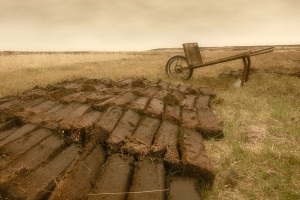Peat: The Great Smoky Divide
A version of this article originally appeared on Distiller last month.
Whisky enthusiasts agree on many things, but they love to argue about peat smoke. As chili peppers are to spicy food, peat is to whisky. Just as people boast of their tolerance for hot peppers in, say a bowl of chili or a fiery vindaloo, whisky drinkers and producers enjoy out-peating each other. All the while other whisky connoisseurs prefer their unsmoked dram, thank you very much. Many whisky fans enjoy both, of course. But they will always inevitably meet the staunch defenders of both sides of the smoke line.
Why is peat in the whisky in the first place?
Peat is a type of soil consisting of partially decayed vegetable matter, found in wet, boggy areas known as ‘peatlands’ or ‘mires.’ The predominant component of it is a type of moss called Sphagnum, which gives it that characteristic, sort of rubbery smell, especially when burned. Dried peat has been used as an effective fuel and heat source in place of wood for centuries, particularly in Ireland, Scotland, England and Russia.
Two of the biggest misconceptions for novice whisky drinkers are that all Scotch is peated, and that it’s only found in Scotch. Peat comes into whisky production as the fuel source for drying barley or other grains (but mostly barley) for malting. However, the grains can be dried without the use of peat, either simply by letting them air dry, which takes quite a long time, or using unpeated fuel such as certain types of wood.
Furthermore, not all peated whisky is the same. You might have rolled your eyes a few times hearing a wine enthusiast use the term terroir to describe the differences between grape varieties in different regions and how that affects the characteristics of specific wines. The same holds true for whisky. Aside from the type of oak used to age a whisky, the other factors that shape the flavors of whisky are the water source, the soil and how the grain was processed, i.e. whether it was peated, which, by the way, is not restricted to Scotland, although that is where the style is most prevalent.
The Islay region of Scotland is known for a particularly fierce style of peated whisky, and this is the variation that earned peated whisky its reputation, with devoted fans and those with a searing intolerance. Thanks to the tempestuous weather conditions and proximity to the sea, Islay whiskies such as Lagavulin, Laphroaig, Bowmore, Ardbeg and Caol Ila tend to taste like the fiery aftermath of a maritime battle, sometimes with rather pronounced elements of seaweed, brine, fish oil, iodine and rubber tire. (One of the more hilarious descriptions of Laphroaig found in their “Opinions Welcome” campaign is that it tastes like “burning hospital.”)
In the Highlands and other parts of Scotland, if used in production (there are many who don’t), the peat, which is found farther inland, lends more of a rich, sweet smoke, more reminiscent of pipe tobacco and even smoked or barbecued meat. Some of the peated Highland malts to look out for are Oban, Benriach, Benromach, Old Pulteney and Clynelish. Highland Park from Orkney has a very subtle charcoal smokiness, while Talisker from the Isle of Skye uses peat smoke as a more dominant element.
Even some distilleries and regions who are known for peat-free maltings release peated expressions. Irish whiskey is traditionally unpeated, but now producers such as Connemara are going peat crazy. The English Whisky Company has peated and non peated styles. Any Glen Garioch Scotch that is older than 1995 hails back to a time they used peated malt, and they are now releasing bottlings such as the 1994 as a peat-nostalgic time capsule. Bruichladdich also reopened as a mostly peat-free distillery, yet you wouldn’t guess it after tasting the Port Charlotte releases. And let’s not leave out the blended Scotches that use peaty single malts for everything from gentle flavor enhancements (Johnnie Walker Black) to creating big in your face
expressions like Compass Box Peat Monster.
Single malt whisky production is catching on outside the UK and Ireland too, even in nations that don’t use peat as an everyday heating source. McCarthy’s out of Clear Creek Distillery in Oregon uses peated barley sourced from Scotland to produce single malt whisky on American shores. Corsair Triple Smoke incorporates peat-smoked barley with cherry wood and beechwood smoked barleys for just a waft of peaty funk. Indian whisky company Amrut is also in on the peat game. Peated Japanese whiskies are of course a thing too.
So just because you might have tried a peated whisky and not fallen madly in love, it’s worth tasting others. It’s like saying you don’t like Chardonnay because it’s too “oaky.” No. Oak is oaky. Peat is peaty. It’s all in how a producer chooses to showcase it and which one works with your palate. And you can’t argue that.



